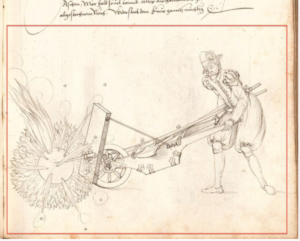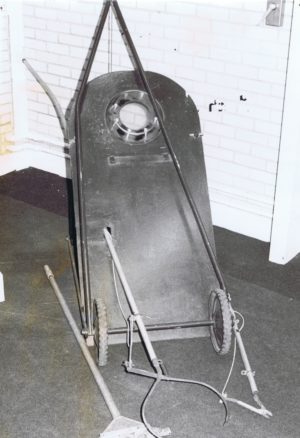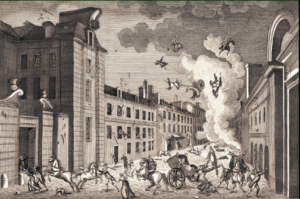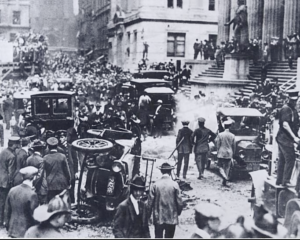I think I have a final piece of the jigsaw here, that links the IEDs used by Lawrence of Arabia, with IEDs used by Jack Hindon in the Boer War and now, the final piece, with a specific IED designed in the US Civil War.
My intent here is to show how a specific IED design, improvised from commonly available battlefield materials, that used the weight of a target train on a gun lock trigger mechanism to explode a charge, seems to have begun in 1864, and that design, or very close approximations of it were then seen in the Boer War decades later, and again in WW1 more than ten years after that. It is of course possible that the design was independently invented – but my supposition is that it was not, and the concept was known by those who deal with explosives in one form or another. The attack mode proved useful in what we would call today “guerilla warfare”, often associated with a firearms firing on the resulting shocked and disorientated survivors.
In bringing these together in a historical sequence I am in part repeating earlier blog posts. In uncovering the details I worked backwards but now I’m laying this out in sequential historical sequence, covering a period from the early 1860s to WW1. I’m specifically looking here at attacks on railways where the weight of the train causes a trigger on a gun “lock” to be initiated – components of firearms were of course used in other sorts of IEDs over many centuries and I have blogged about that here, but that’s outside the scope of this post.
1. US Civil War. Union IEDs designed to attack Confederate trains. As I have blogged before IEDs (then called “torpedoes”) were used extensively by both sides in the US Civil War, with perhaps the Confederates making most application of them. After the end of hostilities the Chief Engineer of the US Army, Brigadier General Delafield collated numerous reports on various Torpedoes used in the conflict and put them into a historical context, examining the efficacy and appropriateness of use. I find it intriguing that Delafield, in the decade prior to the US Civil War was one of the US Army’s observers in the Crimean War which saw extensive use by the Russians of IEDs. In the collated reports is a letter written to Brigadier General Delafield by 1st Lieut Charles R Suter, Chief Engineer in the “Department of the South, Hilton Head, South Carolina, on 26 October, 1864. The letter reads as follows:
By direction of Major General Foster, I have this day forwarded by Adams Express, a box containing a railroad torpedo, tools and drawings showing its use.
This torpedo was devised by Charles F Smith, 3d U.S.C.T.
We have not yet been able to try them on the enemy’s railroads, but they have been thoroughly tested in experiments. The magazine holds 20 to 30 pounds of powder, and this is sufficient to blow a car off the track besides utterly destroying it. Two magazines can be used with one lock and by regulating the length of the powder train, any car of the passing train may be blown up. The accompanying tools are simple and light. The idea of the inventor was, to send small parties of men, 3 or 4 in each, with these torpedoes and return. Each magazine is a load for a man. Another man can carry the lock and another the tools.
The manner of laying these torpedoes is as follows: –
The spikes are drawn from three consecutive ties on one side. A hole is then dug, and the lock placed as indicated in the drawing. The rail is then sprung up and iron wedges placed on the adjacent ties to keep the rail from springing the lock by its own weight. When thus secured, the lock is cocked and capped, and the box closed. The magazine is then buried in the proper place, and the connection made. By using a little care in excavating and carrying off the superfluous earth to some little distance, the existence of the torpedo would never be suspected. The bottom of the arched rail should just touch the lever. Any shock by the bending down the rail pulls the trigger and explodes the torpedo.
In our experiments, a torpedo of 18 pounds was exploded by giving a car sufficient impetus to run over it. The car was entirely destroyed, and rails, ties and fragments of the car were thrown in every direction. One rail was projected 40 feet.
These torpedoes can probably be used with success in some of the larger armies. Their greatest efficiency lies in destroying the locomotive, which cannot be replaced, whereas a torn up track can easily be relaid. the magazine should be tarred before being used.
I am, General,
very respectfully,
Your obd’t serv’t
CHAS R SUTER
1st Lieut, U S Engineers & Chief Eng’r D.S.
Here’s the accompanying diagram:
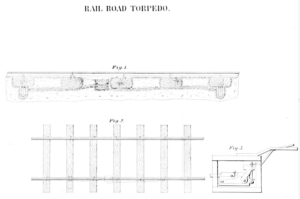
The diagram shows a “lock” from a firearm, with a lever engaging the trigger system. This has been “pre-packaged” is a small box with the initiation mechanism causing a fuze to be lit. The fuze is then connected to two containers (“magazines”) placed under adjacent sleeper ties.
Despite much research I cannot find a report of a “gun-lock” initiated railway IED in the Franco-Prussian War in 1870, five years after the end of the US Civil War. But railway IEDs were used, initiated by the weight of a train on the fuze removed from an artillery shell and was the subject of my last blog post here.
2. The Boer War. Gunlock initiated IEDs were used by the Boers against British Trains in the Boer war in 1901. Here’s a diagram of the adapated Martini-Henry gun lock. The similarities of the US Civil war design of 1865 are clear.
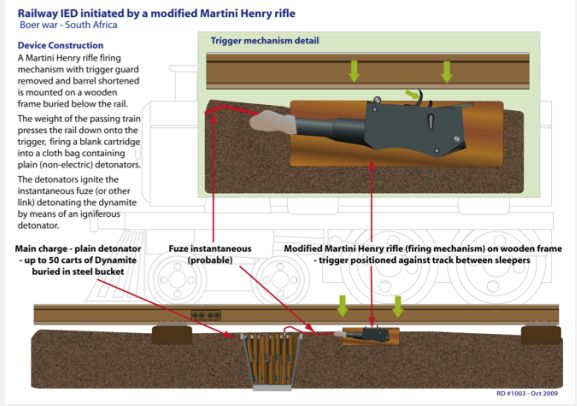
Pictures of actual gunlocks from these devices are at this page
3. WW1 – Lawrence of Arabia and Bimbashi Garland’s attacks on Turkish trains in Arabia. Lawrence of Arabia’s campaign against the Ottoman Turks in the Arabian peninsula in WW1 often attacked the railway lines running south. The IEDs that Lawrence used were pretty much identical to the Boer devices, but had been developed by his ordnance specialist “Bimbashi Garland” and former Ordnance Corps laboratory technician who had been co-opted in the Arab Bureau because of his interest in archaeology. I have no doubt that Garland was aware of the Boer methodology and simply used the same technique. Details are here.
In summary then I think it is clear that the use of a gunlock placed under a railway line to initiate an explosive charge began in 1865, with the invention by Charles Smith, for the Union Army. This technique somehow found its way to the Boers in 1901, and then was copied again by Garland and Lawrence of Arabia in 1917.
